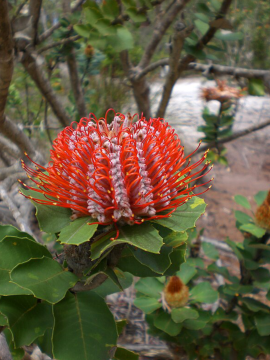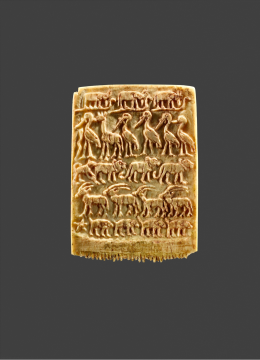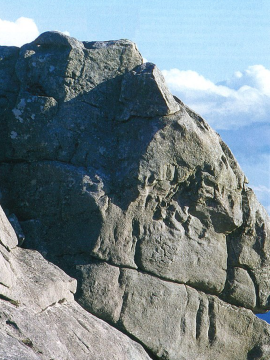On First Looking into a Microscope
Simon Cleary
You’ve spent years trekking through the bush, through mountainscapes, along beaches and riverbanks. You stop regularly on your walks to pause and look around. You think yourself observant. You sit on a boulder and watch a pair of wedgetail eagles rising in a column of hot air. You estimate their wingspan, their respective ages, their altitude. You wonder how far they can see. What they see. How. You make notes in your pocketbook and sometimes sketch what you see and give your little drawings to friends as gifts.
Sometimes, sometimes it’s overwhelming how much you don’t know.
You’re even teaching yourself to tread more softly as you walk, to fold yourself better into the world. It’s taking years but you don’t allow yourself to become discouraged when your bootfall disturbs an eastern grey on the track ahead before you’re aware it’s there. Because it’s not just you: we’re all too sight-dependent.
Just last week you untied the laces of your boots and lowered your feet into the upper reaches of the river you love best and waited, motionless, until fingerlings approached, all dart and nibble and shimmer of light. You slowed your breathing and tried to gather enough impressions of them in that part of the brain beyond cognition, beyond words and measurement, so that later you might draw them from – from what exactly? Intuition? Grace?
You’re curious too. Detail matters. So you read, seek people out, question. Accumulate knowledge, imperfect and incomplete. You understand that beyond the stars is an infinitude being part-mapped, part-imagined, into existence by astrophysicists. And at the other end of the scale you’ve consumed hundreds of articles about worlds too small to see with one’s naked eyes. Things you’ve learnt about how one’s gastrointestinal tract is host to five hundred types of bacteria and how viruses are the greatest threat to the survival of humanity (how dated those journal articles seem now). You’ve seen magnified images of tardigrades and gasped, watched documentaries on life in the soil of pot-plants and held your own at dinner parties with microbiologists. So you understand there is a microscopic universe as inexhaustibly fascinating as the one beyond the sky’s dome.
Yet you’ve never gazed through the lens of a microscope yourself. Ever. Biol held no interest at school and when it came time to choose you studied literature and law at university, those stern mistresses. And, if truth be told, you were once worried about that niece of yours with the magnifying glass in her bedroom and her obsession with insects.
But now, after writing a handful of novels, you have in mind a work of non-fiction, an exploration of rivers and the way they connect – people, places, histories, ecologies, landscapes, myths – with a focus on the river you love most. How easy it’s been to become immersed in the life of the river, to spend time with it every day, a form of contemplation you can’t adequately explain. You carve increasing time out of the day to explore new reaches of the river, meeting with farmers and conservationists and fish-stockers and water-quality scientists. Finding excuses to dip your feet into a flowing stream, to breathe slowly, to dream.
An idea bubbles up from somewhere and takes hold: might the micro-organisms in the water at different sites along the course of the river reveal something about the river’s character as it flows from its ambiguous source to the saltwater bay in the east? (That word, ‘character’, gives you away – the appearance of weightiness, the tendency to anthropomorphise.) And so you ask a young science student friend who’s been studying fungi if he’d be interested in testing the hypothesis. Daniel has a free weekend between finishing his exams and starting work in an environmental consultancy advising farmers about carbon reduction strategies. Thankfully his curiosity is vastly better informed than your own. You return from the river with seven samples scooped from its currents and poured into plastic containers marked 1A, 1B, 2A, 2B, 3A, 3B and 3C, the ‘As’ being clear water, the ‘Bs’ including organic matter found at each site, and the sole ‘C’ scooped from a muddy puddle of mixed river and rainwater formed by overflow from a fierce storm the previous evening.
Daniel arranges to meet the following Monday at the entrance to the Biological Sciences building, one of the sandstone edifices fringing the university’s Great Court. The anticipation is almost too much. Waiting there in the rising summer heat you gaze distractedly across the quadrangle and are surprised when your excitement snags on a memory from twenty years ago. In the sandstone directly opposite, you’d once sat in a tutorial for one of your post-colonial literature subjects and deconstructed the lyrics of Bob Dylan’s A Hard Rain’s Gonna Fall – all Roland Barthes’ recently acquired tools at your disposal – faultlessly identifying every signifier and every signified: Oh, what did you see my blue-eyed son? And what did you see my darling young one?
Daniel leads you enthusiastically into the building, turning one corner then another, deeper and deeper, before stopping at a set of large swinging doors. Your phone vibrates. Although there’s no need to answer it, the memory of what you’d done to Dylan’s song hasn’t quite settled, and you’re not yet ready to enter the lab, not quite ready for whatever it is you’ll see, a part of you suddenly fearful that what you’ll find when you peer down that microscope will spoil your precious river, will strip it of its magic, its beauty. Daniel leaves you to the call, someone seeking advice about something or other. When you’re done you turn the phone off, pocket it, push open the double doors and enter the laboratory.
Rows of long, waist-high benches line the length of the room. There are lone figures at microscopes, and small groups of researchers conversing in huddles, but deciphering all this activity is difficult. Daniel, at the other end of the lab, is transformed, dressed now in his white lab coat. He breaks away from a discussion with his professor to introduce the two of you. She politely asks about your hypothesis but now, surrounded by working scientists methodically practising their discipline, it’s embarrassing how shrill your little theory sounds. The professor smiles and jokes about people being too easily seduced by zoology while remaining ignorant of the fascinations of fungi.
Daniel motions towards a stool. You look earnestly at him as he outlines what to do (earnestness and uncertainty being close cousins), but understand little of what he’s saying, this completely foreign language of instruments, procedures and the specifications of the microscope mounted on the bench. You take your lead from him and mimic the way he lifts a slide from its slot, draws water from one of the sample containers and squeezes a drop onto the slide. You copy him as he places a small clear plastic cover over the slide, pressing down and capturing the water droplet. You mount the slide on the stage as he does, set the magnification as he instructs – 400x – and bend your head.
That bowing of the head. There is submission and there is vulnerability in it. Some act of faith. And, presumably, hope about what you might discover when you turn away completely from the greater human world and enter a microscopic reality, this bending of neck and pressing of eyes on the dual eyepieces of this instrument. For a moment you’re a nun bending her head in prayer, or a barrister bowing to a judge as she enters her court, or a songwriter with his pen sketching the contours of a protest song on the page.
What can you see now, you darling young blue-eyed wonderer?
At first, nothing. Blur. Visual static. Adjustments, coarse and fine. And then something comes into focus and your heart catches. But too quickly it moves across the screen. You grapple with one of the dials, moving the slide hurriedly along the stage, chasing the thing, but you’ve lost it.
You slow your breathing as you’ve practised. Wait. Wait.
Something else appears, a dark mass, circular, quivering. There’s a current eddying around it. You watch it pulsating for a minute, before it suddenly changes shape, longer now, and translucent. Then you realise it’s merely rotated 90 degrees in the water, allowing you to see into it, through it, to a dozen tightly packed, opaque balls that remind you of a cluster of pomegranate seeds. From the upper right of the screen another creature appears (it still feels, in this moment, like it’s a video playing, some footage recorded by someone else). This one is long with catfish whiskers, and swims – the word that immediately comes to mind – towards the pulsating one. It propels its way forward with an initial burst of movement from its tail, then builds on that momentum by shimmying from side to side like a skateboarder generating speed on a footpath after take-off.
Time passes. Or dissolves.
Eagles soar. Water becomes sky. Stars blink and shimmer. Above, below, within. Daniel may or may not be speaking. That may or may not be his hand on your shoulder. You lift your eyes. The look on your face makes him smile. There’s no need to say anything. You bow your head once more.
And you come to understand what it is you’re seeing. That the drop of water is one you collected from the river just two days ago. That on another hot day that same droplet might have been one of a thousand you’d greedily scooped from the river with your hands and raised to your lips to slake your thirst. You understand that within that single drop these are creatures you’re gazing at. They have form, colour, movement, environment. A need for water. A throb of life. You shrink. You expand. You see yourself.
Feature image via 'Art Collection - The Metropolitan Museum of Art'


